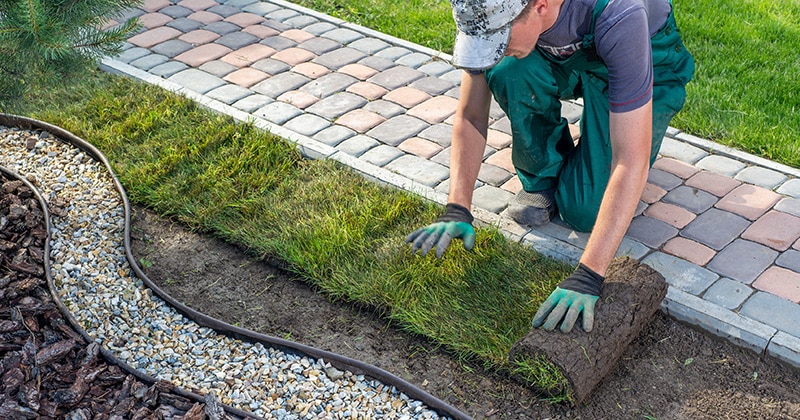You know that pricing your services can be a challenge. You want to offer competitive rates. At the same time, you need to make a profit. It can be difficult to strike the right balance.
In this guide, we’ll walk you through how to price landscaping jobs. We’ll explain how to estimate labor and material costs and choose the right pricing model. We’ll also explore sales strategies for winning new business. Plus, we’ll discuss adjusting your prices to stay competitive in a changing market.
By the end of this guide, you’ll better understand how to price your landscaping services. You can manage your profitability and ensure your business’s long-term success. So let’s get started!
Factors to Consider When Pricing

When deciding how to price landscaping jobs, there are a few key factors to keep in mind. Strike a balance and ensure you’re pricing your jobs fairly and competitively.
Factor #1: The Scope of the Project
The first thing to consider before you bid for landscaping jobs is size and complexity. A small backyard makeover might only take a few hours and cost a few hundred dollars. In contrast, a complete overhaul of a large estate could take weeks and cost tens of thousands of dollars.
For example, say a homeowner wants to add a few new plants and mulch to their front yard. The price would be lower than if they wanted to install a new water feature or build a retaining wall.
Factor #2: The Cost of Materials and Labor
The next thing to consider is the cost of the materials and labor. This includes everything from the plants, mulch, and rocks to the hourly rate of your workers.
For instance, if you are planning to install a new patio, you will need to consider the cost of the pavers, the base, and the sand. You will also need to factor in the cost of the labor, which could be a few hundred dollars per day. A landscaper’s average hourly wage is $23.46.
Factor #3: Equipment and Overhead Costs
The third factor to keep in mind is your equipment and overhead expenses. This includes things like the cost of:
- Landscaping tools
- Insurance
- Office expenses (such as software)
For example, if you need to buy a new lawn mower, you must factor that cost into your pricing. You will also need to consider the cost of your insurance and any office expenses like rent or utilities.
Ultimately, pricing your landscaping jobs is all about finding the sweet spot between fairness and profitability. By keeping these factors in mind, you can ensure that you’re pricing your jobs in a competitive and sustainable way for your business.
Choosing the Right Pricing Model

Once you’ve taken into account the factors we discussed in the previous section, you’ll need to choose a pricing model. There are three main types of pricing models: hourly, flat-rate, and value-based.
Hourly Pricing
Hourly pricing is straightforward. You charge your clients a set hourly rate for the time you spend working on their landscaping job. This pricing model is often used for smaller jobs that don’t need a lot of materials or labor.
Advantages of Hourly Pricing
- Clients only pay for the time you spend working on their project.
- It can be more flexible for smaller, less complex jobs.
Disadvantages of Hourly Pricing
- Clients may be hesitant to agree to an hourly rate without knowing how long the job will take.
- This pricing model may not be as profitable for larger, more complex jobs.
Flat-Rate Pricing
Flat-rate pricing involves charging a set price for the entire job, regardless of how long it takes to complete. This pricing model is often used for larger jobs that need a lot of materials and labor.
Advantages of Flat-Rate Pricing
- Clients know exactly how much they’ll be paying upfront.
- It can be more profitable for larger, more complex jobs.
Disadvantages of Flat-Rate Pricing
- It can be more difficult to estimate the cost of materials and labor.
- Clients may be hesitant to agree to a flat-rate price that seems too high.
Value-Based Pricing
Value-based pricing involves charging a price that captures the value of the service. This pricing model takes into account factors like the complexity of the job and the perceived value of your services.
Advantages of Value-Based Pricing
- It can be the most profitable pricing model if done correctly.
- It allows for a more customized approach to pricing.
Disadvantages of Value-Based Pricing
- It can be difficult to determine the perceived value of your services.
- It may require more negotiation with clients to agree on a fair price.
What to Consider when Choosing a Pricing Model?
When choosing a pricing model to estimate a landscaping job, you’ll need to consider the following factors:
- The size and complexity of the job
- The type of clients you’re working with
- Your own business goals
For smaller, less complex jobs, hourly pricing may be the best option. Flat-rate pricing may be a better choice for larger, more complex jobs. For high-value, customized services, value-based pricing may be the most profitable pricing model.
Ultimately, the pricing model you choose will depend on your own preferences and your clients’ needs. By understanding the advantages and disadvantages of each pricing model, you can make an informed decision and set fair yet competitive prices.
Estimating Labor and Material Costs

You’ve determined the pricing model that’s best for your landscaping business. Next, you’ll need to estimate landscaping jobs, including the cost of labor and materials. This will help you set fair and competitive prices while still allowing you to make a profit.
What’s Included in Labor and Material Cost?
Labor costs include the wages you pay. This includes payments made to both employees and subcontractors. Material costs include the cost of all the materials needed for the job. For example, you might need plants, trees, mulch, fertilizer, and tools.
How to Accurately Calculate Labor and Material Cost Estimates
To calculate labor and material cost estimates, you’ll need to break down the job into more manageable tasks. From there, you can estimate the time and materials each task requires. Then, you can add up those estimates to arrive at a total cost for the job.
Here are some steps to follow when estimating labor and material costs:
- Break down the job into smaller tasks, such as planting, mulching, and pruning.
- Estimate how much time each task will take based on your experience and the job’s complexity.
- Determine the hourly rate for your employees or subcontractors. Multiply that rate by the estimated time for each task to arrive at a labor cost estimate.
- Find out the cost of materials needed for each task. Add those costs to the labor cost estimate to arrive at a total cost estimate for the job.
Consider Setting Up an Accurate Estimating System
Consider setting up an estimating system to ensure your cost estimates are accurate. You might use specialized software or create spreadsheets to track costs. And you might leverage industry-specific formulas to estimate the cost of materials.
An accurate estimating system can help you save time and money. Plus, it ensures your business is sustainable.
RELATED ARTICLE: Effective Landscape Business Planning Tips To Follow
Pricing Strategies for Different Project Types
Pricing landscaping jobs can vary depending on the type of project you’re working on. Here are some pricing strategies to consider for different types of landscaping projects:
Residential Landscaping Jobs
Consider charging a flat rate for the entire job for residential landscaping projects. This can give your customers a clear idea of what to expect. And it allows you to consider the property’s size and the complexity of the work involved.
Another strategy is to charge by the hour. This works especially well if the project involves ongoing maintenance work. This can be a good option for smaller jobs or customers who want to hire you regularly.
Commercial Landscaping Jobs
Commercial landscaping projects can be more complex than residential ones. They often need specialized equipment and expertise. For this reason, consider charging a higher rate for these types of projects.
A value-based pricing strategy may also work well for commercial projects. This involves charging based on the value of your services rather than the time or materials used. This can be a good option for projects requiring a high degree of customization or specialized expertise.
Community Projects
Community landscaping projects can be a great way to give back to your local area. But they often involve working with a tight budget. For these types of projects, offer a discounted rate or even donate your services.
Another strategy is to work with local businesses to sponsor the project. This can help cover the cost of materials and labor. At the same time, you can promote your business and give back to the community.
Sales Strategies

Pricing your landscaping jobs is just one part of the sales process. To win more business and build strong customer relationships, use effective sales strategies. Here are some tips to help you close more deals:
Detailed Proposals
When providing a landscaping estimate to a potential customer, always be as detailed as possible. Include the following in your proposal:
- A clear description of the work to be done
- A breakdown of the costs involved
- An estimated timeline for completion
A detailed proposal can help you build trust with your customers. It also shows them that you’re serious about delivering high-quality work.
Effective Communication
Effective communication is vital to building strong customer relationships. Make sure you listen to your clients’ needs and concerns. Be sure to explain your process clearly and concisely. This will help your customers understand what they can expect from your services. It cultivates trust in your ability to deliver.
Addressing Customer Questions and Concerns
As you work with your clients, you may encounter questions or concerns about the work you’re doing. It’s essential to address these issues in a timely and professional manner. Be responsive to emails and phone calls. Take the time to explain any problems or concerns in an easy-to-understand way.
Adjusting Prices for Market Trends
Market trends can have a significant impact on the pricing of landscaping services. These trends include economic changes, weather patterns, and even customer demand. To stay competitive in the industry, it’s critical to adjust your prices accordingly. Here’s what you need to know about changing prices for market trends:
Understanding Landscaping Industry Trends
Market trends refer to changes in the industry that affect the demand for landscaping services. These trends can be local, regional, or national.
For example, say your area experiences an economic downturn. This may result in a decrease in demand for higher-end landscaping services. You might need to lower your prices to stay competitive among other landscaping businesses.
And here’s a real-world example that might be familiar. The pandemic, high demand for outdoor products, and challenges with labor and transportation have caused a shortage of supplies for landscapers. To prepare for these challenges, landscapers may keep more inventory than usual. This ensures they have enough supplies to complete their jobs.
FROM ONE OF OUR PARTNERS: 13 Lawn Care & Landscaping Industry Trends
Determining When to Adjust Pricing
To determine when to adjust your pricing, you should closely monitor market trends. Watch for changes in customer demand and sentiment. You can also analyze your competition to see how they price their services. If you notice that your competition is offering similar services at lower prices, it may be time to adjust your pricing. That way, you remain competitive.
Optimal Times for Adjusting Pricing
There are several optimal times to adjust your pricing. During the off-season or slower times of the year are two examples. This can attract new customers and keep existing ones. Additionally, if you’re introducing a new service or product line, consider changing your pricing to reflect the additional offerings.
Monitoring and Managing Profitability

Profitability is the money your business earns after you’ve paid all your expenses. It’s important because if you’re not profitable, your business won’t be able to survive in the long run.
Importance of Monitoring Profitability
To make sure your business is profitable, you need to monitor it regularly. This means tracking how much money is coming in and going out. You can do this by looking at your financial statements. Consider your income statement and balance sheet.
Here are some tips for monitoring profitability:
- Set financial goals. Determine how much profit you want to make each month or year.
- Track your expenses. Keep track of how much money you spend on labor, materials, and equipment.
- Review your pricing strategy. Make sure your prices are high enough to cover your expenses and make a profit.
- Analyze your financial statements. Look for trends in your income statement and balance sheet. This might include increases or decreases in revenue or expenses.
- Seek professional help. Consider hiring an accountant or financial advisor to help you track your profitability.
Strategies for Improving Profitability
To improve your profitability, you can:
- Increase your prices. If your fees are too low, consider raising them to cover your expenses and make a profit.
- Reduce your expenses. Look for ways to cut costs, such as buying materials in bulk or finding more affordable equipment.
- Increase your efficiency. Find ways to complete jobs more quickly or with fewer resources.
- Diversify your services. Offer new services to attract more customers and increase your revenue.
Monitoring and managing your profitability can ensure your business stays financially healthy. This can help it succeed today and in the long run.
RELATED ARTICLE: 5 Things to Avoid When Running Your Landscape Business
Priced for Success
Figuring out how to price landscaping jobs can be tricky. But with the tips and strategies shared in this guide, you can do it like a pro. Get started today by:
- Writing down important factors like materials, labor, and equipment.
- Reassessing your pricing model and ensuring it works for you and your clients.
- Revisiting your communication strategy. Is it effective? Is your pricing transparent? What could you do to improve it?
- Researching the market trends. Are your prices in line with your competition?
- Calculating your profitability and ensuring it supports your long-term success.
By following the advice in this guide, you’ll be on your way to pricing your landscaping jobs fairly and providing high-quality services to your clients. So go ahead, put your knowledge into practice, and watch your landscaping company grow. Good luck!